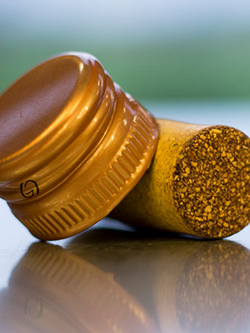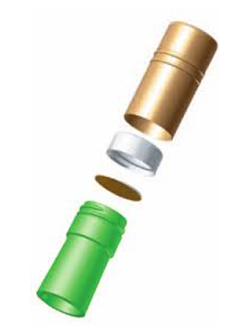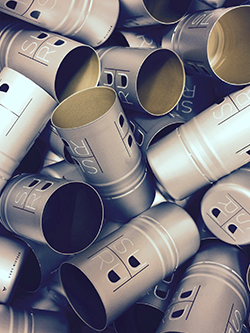Corks vs Screw Caps
 Ever wondered about the differences between the traditional cork closure and the more modern screw caps? Today we are taking a deep dive into the two technologies and shedding light on the history and benefits of the two!
Ever wondered about the differences between the traditional cork closure and the more modern screw caps? Today we are taking a deep dive into the two technologies and shedding light on the history and benefits of the two!
A Brief History of the Corks
Cork has been in use since 3000 BC and is used in a wide variety of products including shoes, flooring, bags, and of course as a closure for wine. Cork products are made by harvesting the bark of a Quercus Suber oak trees aka a Cork Oak, which takes 25 years of growth to reach maturity and to a point where the bark can be harvested. The process of harvesting is done by hand by specially trained cork harvesters who strip the bark from the trees using an axe.
As an organic material cork is a wonderful natural product, however as with any organic material it is subject to contamination. One of the reasons cork has been the material of choice for centuries is that its porous nature allows gradual oxidation for the wine as it bottle ages. However because it is a natural product there can be quite a lot of variation from cork to cork which can lead to something called sporadic oxidation.
Sporadic oxidation is the result of inconsistency in pore size of the cork, leading to the allowance of more or less oxygen to pass through the cork into the bottle. This can result in a browning in color, maderized (baked or stewed) character, loss of primary fruit and a general flattening of flavors and shortening of the finish of the wine. This comes from the varying elasticity of the corks, more or less lenticels (holes size and quantity), the internal bore of the glass neck, imperfections of the corking machinery can cause slices in the cork all of these can create variable issues with a perfect seal.
Cork Contamination aka "Corked" Wine
One of the other most commonly referred to downsides of cork closures is TCA (trichloroanisole), the primary form of wine contaminantion, also referred to as a “corked” or spoiled bottle of wine.
TCA is created when chlorine comes in contact with molds that form naturally in the bark of Quercus Suber oak trees. Chlorine is introduced during the washing of the bark when it is cut and from spray residue from pesticide sprays on the trees. Some of the tell-tale signs of a TCA contaminated or "corked" bottle of wine is a ‘wet-cardboard’ and ‘wet dog’ aromas, paired with suppressed fruit and a shortened finish. The flavor and aromas are distinct and are easy to pick-out once you know what to look for. The wine industry estimates that between 5-10% of all wine bottled under cork has some level of TCA.
 Introduction of Screw Caps
Introduction of Screw Caps
In August of 1889 Dan Rylands of Barnsley in the UK patented the screw cap, however it would be another 70 years before screw caps were used in wine packaging.
If you look inside a screw cap you will see a coating on the interior which is its PVDC liners (polyVINylidene chloride) essentially the ‘wine-proofing layer.’ This is then coupled with either Tin or Saranex backing based on the winemaker's preference. Tin linings (which are 10% more expensive) prevent oxygen exchange and retain freshness in a wine. Tin linings are primarily used for white and rosé wines. On the other hand, saranex linings which are mainly used for red wines allow the wine to breathe.
In 1959 a French company, Le Bouchage Mecanique (now Pechiney) was the first to use screw caps on a wine bottle. In the 1960's a Bordeaux winery bottled multiple vintages in screw caps as a trial to test out the new technology. Unfortunately for them they used paper wad backing not saranex in the cap. Ten years later in the early 1970's the Swiss wine industry was the first to fully embrace the new screw cap closures and by 1980's it was the predominant closure being used.
In the 1970’s Australia confirmed the superiority of the closure for red and white wines using tin or Saranex depending on the wine, but the change was met with strong consumer resistance. However in the early 2000’s the industry once again embraced this closure (starting with Claire Valley high-end Riesling producers) and over the last two decades screw caps have gained industry and consumer popularity across the globe.
Corks vs Screw Caps, Which is Better?
 A closure has a direct impact on the quality, stability, longevity and even proper storage of the wine. While cork has been the historic choice and for a great many years was the best option available, in the modern age screw caps have become superior due to the consistency they provide.
A closure has a direct impact on the quality, stability, longevity and even proper storage of the wine. While cork has been the historic choice and for a great many years was the best option available, in the modern age screw caps have become superior due to the consistency they provide.
Screw caps offer a reliable seal that is consistent from bottle to bottle unlike cork which due to the fact that it is an organic material has slight variations from one cork to another that result in slight differences, and sometimes spoilage in the bottle.
One of the other main benefits and one that is often overlooked is that screw caps are inert, meaning they are flavorless and do not add any flavor (be it positive or negative) to the wine. On the other hand corks, introduce flavor both positive through slow oxygen exchange which allows wine to age in the bottle as well as negative (TCA) which results in spoilage. Screw caps, while inert, can be customized to allow for gradual slow oxygen exchange by adding a foam insert to the top of the screw caps interior thus mimicking the slow oxygen exchange of corks.
Temperature is often discussed as one of the main detriments to wine as it deteriorates the quality of the wine over time and causes spoilage. If you have ever opened a bottle of wine after it has sat baking in a car on a hot summers day you know what I'm talking about, the wine gets "cooked" and no longer tastes as it should. While a wine can get "cooked" no matter what closure you have, when a bottle with a traditional cork closure reaches 85 degrees Fahrenheit the cork will start pushing its way out of the top of the bottle exposing the wine to more oxygen and increasing the rate of spoilage/oxidation over time, whereas with screw caps you don’t run into this issue as the caps can hold more internal pressure and therefore are less effected by temperature swings.
Another main benefit of screw caps is their price, while pricier options do exist, there are affordable options when compared to many of their cork/capsule counterparts, meaning less packaging costs for the winery and therefore a better bottle price for the consumer, a win-win for everyone! For comparison, a natural cork costs $0.25 - $0.45 per cork plus the capsule is an additional $0.15 for polylamanents or roughly $0.02 for plastic. A stelvin screw caps costs $0.18 per cap and the higher end lux screw caps costs $0.50.
And if all of that wasn't enough to convince you that screw caps are the way of the future, one of our favorite features are how easily screw caps can be opened and resealed. No need to struggle with a corkscrew or ensure you have one on you, all you have to do is give the bottle a quick twist and your wine awaits! In addition to the ease of opening, screw caps are a green product, the are cost effective and easily recycled. Aluminum (what screw caps are made of) happens to be the most cost effective material to recycle and if that's not a plus I don’t know what is!
Suhru has been proudly packaging our wines under screw caps since we opened in 2008 and have seen great success in the age-ability of our wines under these closures. Many experiments have been done in regions across the world comparing screw caps to cork and the screw caps has come out equal if not better than the cork at aging in may cases. While it may be a "less romantic" way to open your wine, you can't beat the convenience!
